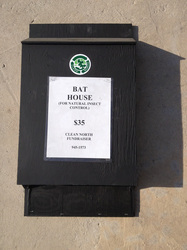Bat Houses from Clean North
Did you know a single little brown bat can catch 600 mosquitoes in just one hour?! And that a typical insectivorous bat menu might include moths, mosquitoes, crickets, and even scorpions.
Bat houses provide summer roost areas; Bats will not hibernate in these houses.
Clean North's Bat House is made from reclaimed wood, and is painted black to help warm the house (needed in this northern environment). They are available at Lemieux Composting for $35.
Bat houses provide summer roost areas; Bats will not hibernate in these houses.
Clean North's Bat House is made from reclaimed wood, and is painted black to help warm the house (needed in this northern environment). They are available at Lemieux Composting for $35.
Bat houses can have occupancy rates ranging from below 20% to over 80%, depending on many factors such as the house design, its location, and the population of bats already in the area. Don't be discouraged if bats don't roost in your bat house right away have patience and give them two full summers before relocating or modifying the house.
It is better to have a larger bat house because the heat is more even and it acts as a heat sink. It will also be a lot easier to attract more bats. Houses with several internal baffles will hold more bats and they will help keep each other warm.
Location is extremely important. Bat houses are most successful when you place them on chimneys, polls, mounted on a building or on anything 15 feet or higher. It should receive several hours of morning and afternoon sun.
The best way to attract that is to place the bathhouse where bats are known to exist. That houses that are placed Nearwater will attract a lot of that. They need space and protection from predators and obstacles to provide adequate flight.
You need to wait at least two full summers before you move or make any alterations to the bat house. Bats are extremely vocal during the day and you'll be able to hear them. You can also tell if there bats by bat droppings. Their droppings are excellent for fertilizer.
By far the most common species of bat to be reported in this part of Canada is the little brown bat. You won't likely find any other kind.
Bat houses that are mounted on buildings, are the safest places from predators. If you're bat house is on a pole you should wrap predator guards or tinfoil around the pole that the Bat house is mounted on. This will stop predators from climbing.
A bat house will not interfere with a birdhouse; birds and bats do not compete for food or space.
It is better to have a larger bat house because the heat is more even and it acts as a heat sink. It will also be a lot easier to attract more bats. Houses with several internal baffles will hold more bats and they will help keep each other warm.
Location is extremely important. Bat houses are most successful when you place them on chimneys, polls, mounted on a building or on anything 15 feet or higher. It should receive several hours of morning and afternoon sun.
The best way to attract that is to place the bathhouse where bats are known to exist. That houses that are placed Nearwater will attract a lot of that. They need space and protection from predators and obstacles to provide adequate flight.
You need to wait at least two full summers before you move or make any alterations to the bat house. Bats are extremely vocal during the day and you'll be able to hear them. You can also tell if there bats by bat droppings. Their droppings are excellent for fertilizer.
By far the most common species of bat to be reported in this part of Canada is the little brown bat. You won't likely find any other kind.
Bat houses that are mounted on buildings, are the safest places from predators. If you're bat house is on a pole you should wrap predator guards or tinfoil around the pole that the Bat house is mounted on. This will stop predators from climbing.
A bat house will not interfere with a birdhouse; birds and bats do not compete for food or space.


